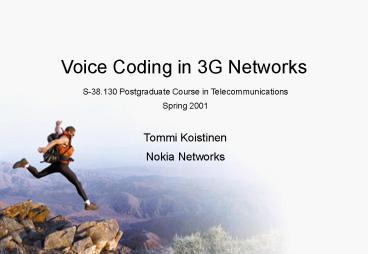Voice Coding in 3G Networks - PowerPoint PPT Presentation
Title:
Voice Coding in 3G Networks
Description:
S-38.130 Postgraduate Course in Telecommunications Spring 2001 Tommi Koistinen Nokia Networks 3GPP Release 99 R99; first phase of 3G entities involved with speech ... – PowerPoint PPT presentation
Number of Views:75
Avg rating:3.0/5.0
Title: Voice Coding in 3G Networks
1
Voice Coding in 3G Networks
- S-38.130 Postgraduate Course in
Telecommunications - Spring 2001
- Tommi Koistinen
- Nokia Networks
2
Contents
- PART I
- Short introduction to 3GPP reference architecture
models - Media Gateway (MG)
- Multimedia Resource Functions (MRF)
- PART II
- Speech compression why ?
- Tandem avoidance
- Adaptive Multirate (AMR) speech codec
- Wideband speech coding (AMR-WB)
- Demonstrations
3
3GPP Release 99
- R99 first phase of 3G
- entities involved with speech processing are
circled with red
4
3GPP R4
- separates MSC to MSC Server and to Media Gateway
5
3GPP R4R5
- IP Multimedia Subsystem (IMS)
6
Media Gateway
- support for several interfaces (A-interface for
2G and Iu-interface for 3G) and for several
transmission protocols (ATM, IP, TDM) - support for several codecs including the Adaptive
Multirate (AMR) codec and future coming wideband
codecs - electric and acoustic echo cancellation
- announcement services
- DTMF and call progress tone generation and
detection - support for fax/modem/data protocols
- support for Tandem Free Operation (TFO) and
Transcoder Free Operation (TrFO) - bad frame handling
- IP protocol handling (RTP/RTCP, encryption, QoS
support)
7
Media Resource Functions Unit
- audio/video conferencing services
- speech enhancements ?
8
Tandem Avoidance in 2G
Current status no Tandem Free Operation (TFO)
9
Tandem Avoidance in 2G
Better speech quality with Tandem Free Operation
(TFO)
10
Tandem Avoidance in 3G
Transcoder Free Operation (TrFO) AMR modes are
negotiated by inband procedure.
11
Speech Compression Why ?
- to save transmission capacity
- to save radio resources
- to save storage capacity
- more compression (40) with voice activity
detection (VAD) and discontinuous transmission
(DTX) - error robustness with bad frame handling (BFH)
12
Speech coding techniques
- Waveform coders
- correlation between adjacent samples
- G.711, G.726 ADPCM etc.
- Analysis-by-synthesis types of coders
- Code Excited Linear Prediction (CELP)
- G.723, G.729, GSM EFR, GSM AMR
13
The CELP model
vocal tract
glottis
14
Adaptive Multirate (AMR) speech codec
- only mandatory codec for 3G
- improved speech quality in both half-rate and
full-rate modes by means of codec mode adaptation
i.e. varying the balance between speech and
channel coding for the same gross bit-rate - ability to trade speech quality and capacity
smoothly and flexibly by a combination of channel
and codec mode adaptation this can be controlled
by the network operator on a cell by cell basis
15
AMR source rates
16
Structure of AMR encoder
17
Encoder output
18
Structure of AMR decoder
19
Demostration I Full Rate vs. AMR-NB
- Erroneous channel (C/I 264 dB)
- 1. sample FR 13 kbps
- 2. sample AMR-NB 5.9-12.2 kbps
20
Wideband speech coding
- Narrowband 300 3400 Hz
- Wideband 50 7000 Hz
- Wideband AMR speech codec (3GPP R5)
21
AMR-WB source rates
22
EFR vs. AMR-NB vs. AMR-WB(in 16 kbps full rate
traffic channel)
AMR-WB
Excellent
AMR-NB
Very good
Subjective speech quality
EFR
Good
Poor
Unacceptable
Error-free
13
10
7
4
Carrier-to-interface ratio (dB)
23
Demostration II AMR-NB vs. AMR-WB
- Clean speech (highest modes)
- 1. sample AMR-NB 12.2 kbps
- 2. sample AMR-WB 23.85 kbps
24
Demostration III GSM EFR vs. AMR-WB
- Erroneous channel
- 1. sample GSM EFR 12.2 kbps
- 2. sample AMR-WB 6.6-14.25 kbps
25
Demostration IV AMR-NB vs. AMR-WB
- Music (highest modes)
- 1. sample AMR-NB 12.2 kbps
- 2. sample AMR-WB 23.85 kbps































